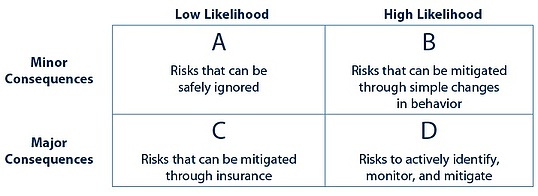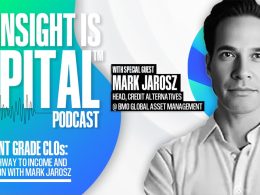8 Potential Risks in Your Financial Advisory Practice
by Commonwealth Financial Network
 Business risk is anything that threatens the continued success of your practice, and it can assume many forms. Unfortunately, many business owners overlook the potential risks that can derail a long-standing business. Why? Generally because they don’t understand the risk, don’t feel the risk is severe, or don’t believe it will happen. But what if it does?
Business risk is anything that threatens the continued success of your practice, and it can assume many forms. Unfortunately, many business owners overlook the potential risks that can derail a long-standing business. Why? Generally because they don’t understand the risk, don’t feel the risk is severe, or don’t believe it will happen. But what if it does?
Of course, you won’t always know what brand of mayhem will disrupt your business, but that doesn’t mean you can’t prepare. To get you started, I’ve outlined eight potential risks in your financial advisory practice. By understanding and addressing these risks, you’ll be better positioned to protect your business—and your clients—before it’s too late.
The competition present in the financial planning and advice industry is constantly growing and changing. According to market research firm IBISWorld, the revenue in the U.S. industry has grown 5.5 percent over the past five years, and Ameriprise Financial, Bank of America, Morgan Stanley Wealth Management, and Wells Fargo hold the largest market share in this space. The competition with robo-advisors is also heating up, with companies such as Wealthfront, Betterment, and Acorns providing state-of-the-art mobile applications and innovative investing methodologies.
Changing client demographics are calling for high-tech, high-touch services for the emerging affluent market. If you want to score new, ideal clients, explore ways to reach out to millennials, and be prepared to talk about the value you provide compared with the competition (i.e., service, trustworthiness, and quality relationships).
Perhaps you’re familiar with the expression, “If you’re green, you’re growing; if you’re ripe, you’re rotting.” Although you’ve worked hard to get where you are, some growth will enable you to reinvest in more client services in this competitive market. Further, given fee compression and increased competition for client dollars, finding ways to grow is even more important. A few options for managing this growth include merging with other firms, building infrastructure, and segmenting services for clients.
Clients with specific needs look for advisors with specialized knowledge, so developing your services around a particular niche can help with attracting ideal clients. In fact, CEG Worldwide research shows that 70 percent of advisors earning at least $1 million annually focus on a niche, but only 35 percent of those earning less than $150,000 a year have a specialization. This data suggests that if you don’t have a niche focus currently, it could be a great next move to grow your firm.
So, what does providing specialized services mean, exactly? For example, if you have knowledge of divorce and access to ancillary advisors, you may be better positioned to serve individuals going through a marriage breakup. Another option is to merge with other advisor firms with complementary services and expertise. By forming teams, you can present a more complete service offering for clients looking for that “one-stop shop.”
It’s well documented that millennials favor financial advice supported by technology. In a survey by Roubini ThoughtLab, 59 percent of millennials say they use social media to communicate with advisors, and 39 percent say they use web collaboration tools—and these numbers are expected to continue to grow. If possible, consider meeting virtually with younger clients, or use Twitter or LinkedIn to reach out to this group—just as they are using social media to learn more about you.
Technology has also affected trading tools and automation, facilitating timely trades and delivery of sophisticated investment strategies and creating more safeguards against market downturns. Your ability to use these tools may be the decisive strategic edge to attract clients. Plus, investing in technology can create efficiencies, drive profitability, and enable you to continue to thrive.
Even with the rise of technology, don’t underestimate the human touch. A recent ETF Trends article discusses how the market knowledge and financial planning and decision-making skills advisors possess make them indispensable and irreplaceable compared with their robo-competitors. But you’ll need to do your part in helping clients recognize your value by employing the best-of-the-best humans to work with them.
A human resources manager can help ensure smart hires. If smart hiring practices are not used, your advisory business could face a plethora of human capital risks:
- Failure to attract employees
- Hiring of the wrong person
- Unsatisfactory performance
- Turnover
- Absenteeism
- Accident/injury
- Fraud
- Social problems
- Legal/compliance issues
Any of these risks could interrupt your business; two or three at the same time could seriously disrupt it.
You’re well aware that the SEC regulates financial firms. Yet debacles like the Enron and Wells Fargo scandals, Bernie Madoff, and the 2008 financial crisis happened—and we can expect similar events to continue to happen. Most advisors expect more, not fewer, regulations in the future.
It’s vital to keep abreast of what’s happening in the industry, as increased regulations would require careful planning and allocation of resources to ensure that compliance does not derail the profitability of your firm.
Here at Commonwealth, our Practice Management team has observed that advisors tend to experience “pain points” at predictable intervals:
- At $250,000 of production, advisors generally need to think about administrative staff to support the next growth spurt.
- At $450,000, advisors need technical support and typically hire a paraplanner or research advisor.
- At $750,000, advisors are reaching capacity as solos and need to address efficiency within the practice by analyzing and segmenting their service model and pinpointing their growth plan.
How can you deal with these pain points? Start by creating repeatable office procedures, as well as understanding revenue distribution among clients, profitability by client, and optimal service models. These strategies may help you achieve the level of growth you need while providing the service that you want for clients.
When it comes to protecting yourself, I’m reminded of an old insurance sales question: “If you had a money machine in your basement that pumped out $600,000 a year, would you insure it?” Of course, the punch line is that you are the money machine. Are you protecting yourself against the losses that could derail your money machine? Significant loss threats include advisor death or disability, key person loss, an unexpected disaster (natural or otherwise), lawsuits, and failure to plan for business succession.
Here, best practices include insurance and continuity plans to protect those assets you cannot afford to lose. Also, be sure to perform annual reviews to update these plans in response to changing market conditions.
Now that we’ve covered some common business risks, you’re ready to experiment. First, draw a risk matrix with four quadrants (see chart below). Next, label the row headers with the consequences of risk and the column headers with risk likelihood. It might be helpful to brainstorm the risks you perceive in your firm and categorize them.

Last but not least, build a business plan to address each quadrant until you’re confident that you’ve addressed the most important risks.
- Develop a vision: Where do you want to be in five years? What would you like to accomplish?
- Assess SWOT: Understand your firm’s strengths and weaknesses on the inside and opportunities and threats on the outside.
- Develop strategic directives: What actions can you take to achieve your firm’s vision while keeping risk reduction in mind?
- Create meaningful annual goals: Use SMART goals—strategic, measurable, achievable, realistic, and time-bound.
- Develop a plan of action: List tasks and timelines to achieve your goals.
- Implement: A wise person once told me, “At some point, everything degenerates to work.”
- Review annually: By building time to track goals, you’ll be able to adjust your plan accordingly.
Armed with an understanding of these common business risks, you’ll be better prepared for what may lie ahead. I’ll leave you with these words spoken by Warren Buffett after the 2008 financial meltdown: “You only find out who is swimming naked when the tide goes out.”
Do you have a plan in place to address risks in your financial advisory practice? Do you think you’re sufficiently prepared to evolve with changes in our industry? If not, why not? Please share your thoughts with us below.
Editor’s Note: This post was originally published in March 2016, but we’ve updated it to bring you more relevant and timely information.
Commonwealth Financial Network is the nation’s largest privately held independent broker/dealer-RIA. This post originally appeared on Commonwealth Independent Advisor, the firm’s corporate blog.
Copyright © Commonwealth Financial Network















